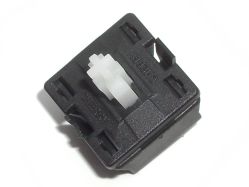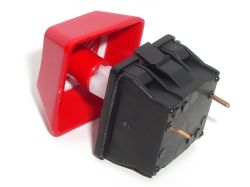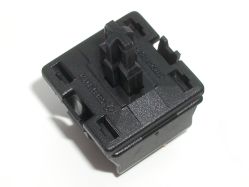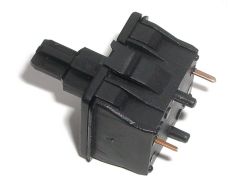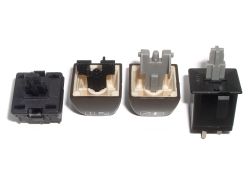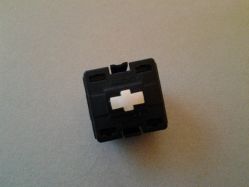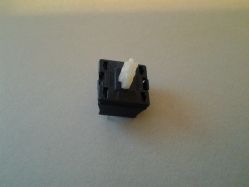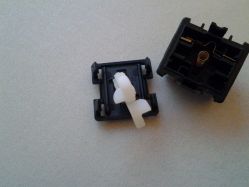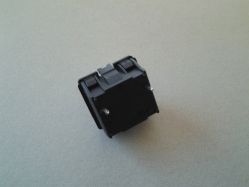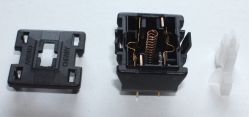Cherry M9
| This article requires additional photographic illustration — disassembly, plus all teh variantses! |
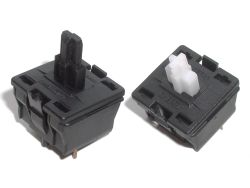 | |
| Manufacturer | Cherry |
|---|---|
| Product code | M9xx-xxxx |
| Switch type | Linear/Tactile |
| Sense method | Metal leaf |
| Keycap mount | Cherry MX mount, other(s) |
| Switch mount | Plate mount, PCB mount |
| Patents | US 4339643 (1980) |
Cherry M9 is the medium-height keyswitch from Cherry that preceded the Cherry MX range.
Description[edit | edit source]
In their 1982 catalogue, Cherry listed three different sizes of keyswitch: Cherry M7 ("Standard Mounting Height"), Cherry M8 ("Super Low Profile") and Cherry M9 ("Low Profile"). Cherry M9 switches are designed to sit almost entirely below the plate, with a 9.14 mm distance from the top of the plate to the top of the PCB (down from 17.4 mm in the Cherry M7). From the diagram, this gives a total switch height of 12 mm. This corresponds closely with the 11.6 mm overall height of the Cherry MX switch, but with a requirement of a taller PCB−plate gap. Less than 3 mm of the switch is above the plate.
The MX shell design, including its retention clips and four top release holes, is quite similar to the M9's. However, the M9 is usually mounted with latches on top and bottom, rather than the sides, as with the MX.
The contact mechanism is the same as the Cherry M8, with a lateral movable leaf.<ref name="Parak" />
The switch shell and slider can accommodate separate contact mechanisms for two circuits. In most cases, M9 switches are Cherry MX mount (seemingly a misnomer if M8 and M9 had this mount first).
Cherry M9 switches are fairly uncommon and appear to be more likely to be found in typewriters than computer or terminal keyboards. According to dates on shipping boxes, it was produced until at least 1985.
US patent 4339643 filed in 1980 describes a tactile double-action version and claims that this switch has hysteresis; no explanation for the hysteresis is immediately obvious and the term only appears once in the text of the patent.
Variants[edit | edit source]
This series is likely to contain many variants, some of which are listed below.
| Article number | Type | Mount | Keystem | Switch mount | Branding | |
|---|---|---|---|---|---|---|
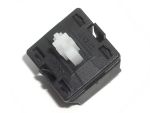 |
M94A-18NI | Momentary SPST linear | Cherry MX | Angled | Plate | Textual |
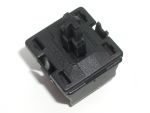 |
? | Momentary SPST linear | ? | Upright | Plate/PCB | Graphical |
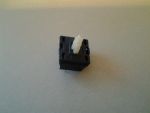 |
? | Momentary SPST linear | Cherry MX | Upright | Plate | Textual |
 |
? | Momentary DPST linear | Cherry MX | Upright | ? | Textual |
| File:No photograph.svg | ? | Momentary SPST linear illuminated | ? | Angled | ? | Textual |
Keyboards[edit | edit source]
Typewriters / Word Processors[edit | edit source]
- Adler Gabriele 8008 <ref name="DT-8008" />
- Triumph-Adler Alpha 610
Gallery[edit | edit source]
M94A-18NI[edit | edit source]
M94A-18NI is Cherry MX mount, plate mount only. The keystem is angled. The switch below was obtained through the community of ultimately unknown origin. The Cherry branding is the old textual form.
-
Top
-
Cherry MX mount confirmed using Signature Plastics keycap
Mitsumi mount[edit | edit source]
This switch was obtained NOS from Bulgarian store Optron (ppetkov-sz.com). The tall, upright keystem uses the same mount as Cherry M51-0131; the Mitsumi keycaps from the Commodore 64 fit these switches, while Cherry MX keycaps do not fit as the keystem cross dimensions are too large. The switch is dual PCB/plate mount. This variant is notable for having a graphical Cherry logo, which is rare for M9 switches.
-
Top
-
Keycap and switch mounts
-
Keycap mount comparison with Cherry M51-0131
SPST NO[edit | edit source]
The example below appears to be derived from a linear double-action switch, as one actuator ramp deliberately holds the contact open longer. Only the stage one ramp is used, and the parts for the second stage are not present. No other details about the switch are known.
DPST NO[edit | edit source]
No details about this switch are known.
-
Switch with contacts for 2 different circuits.
Illuminated[edit | edit source]
This version features an LED fitted to the top of a tall mounting post. The keystem is angled, and the keycap mount is uncertain; it appears that it also accepts the same keycaps as Cherry M51-0131.<ref name="Parak" />
References[edit | edit source]
<references> <ref name="Parak">Imgur — Cherry Switchery Dated 2013. Retrieved 2015-07-23.</ref> <ref name="DT-8008">Deskthority — Cherry M9 switches</ref> </references>
